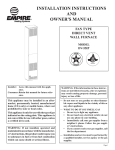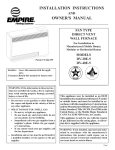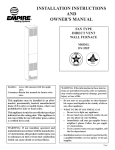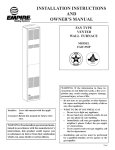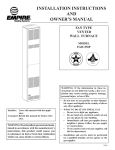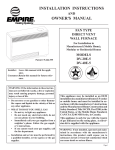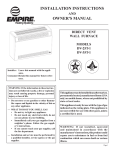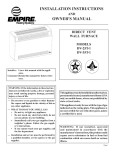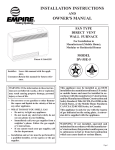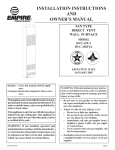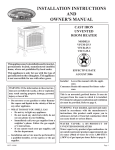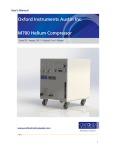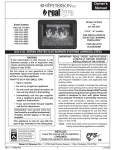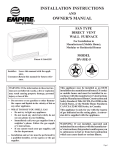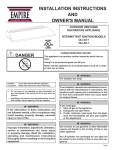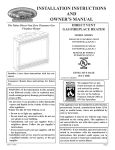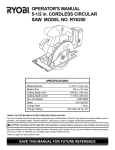Download Empire Heating Systems DV-55IPT-1 Owner`s manual
Transcript
INSTALLATION INSTRUCTIONS AND OWNER'S MANUAL FAN TYPE Direct Vent Wall Furnace Model DV-55IPT-1 Installer: Leave this manual with the appliance. Consumer:Retain this manual for future reference. Thisappliancemaybeinstalledinanaftermarket, permanently located, manufactured home (USA only) or mobile home, where not prohibited by state or local codes. This appliance is only for use with the type of gas indicated on the rating plate. This appliance is not convertible for use with other gases, unless a certified kit is used. WARNING: If not installed, operated and maintained in accordance with the manufacturer's instructions, this product could expose you to substances in fuel or from fuel combustion which can cause death or serious illness. WARNING: If the information in these instructions are not followed exactly, a fire or explosion may result causing property damage, personal injury or loss of life. — Do not store or use gasoline or other flammable vapors and liquids in the vicinity of this or any other appliance. — WHAT TO DO IF YOU SMELL GAS • Do not try to light any appliance. • Do not touch any electrical switch; do not use any phone in your building. • Immediately call your gas supplier from a neighbor’s phone. Follow the gas supplier’s instructions. • If you cannot reach your gas supplier, call the fire department. — Installation and service must be performed by a qualified installer, service agency or the gas supplier. Page 1 TABLE OF CONTENTS Section Page Important Safety Information.......................................................................................................................3 Vent Kit Information.....................................................................................................................................3 Safety Information for Users of LP Gas.......................................................................................................4 Requirements for Massachusetts...................................................................................................................5 Introduction...................................................................................................................................................6 Specifications................................................................................................................................................6 Gas Supply................................................................................................................................................ 7-8 Clearances ....................................................................................................................................................8 Installation Instructions........................................................................................................................... 9-11 Lighting Instructions . ................................................................................................................................12 Pilot Flame Characteristics ........................................................................................................................13 Main Burner Flame Characteristics ...........................................................................................................13 Wiring.........................................................................................................................................................14 Service and Maintenance Suggestions.................................................................................................. 15-16 Troubleshooting.................................................................................................................................... 17-18 Parts List ....................................................................................................................................................19 Parts View...................................................................................................................................................20 Master Parts Distributor List .................................................................................................................... 21 How To Order Repair Parts . ..................................................................................................................... 21 Service Notes........................................................................................................................................ 22-23 Page 2 13281-9-0709 IMPORTANT SAFETY INFORMATION This Is a Heating Appliance Do Not Operate This Appliance Without Front Panel Installed. • Due to high temperatures the appliance should be located out of traffic and away from furniture and draperies. • Children and adults should be alerted to the hazards of high surface temperatures and should stay away to avoid burns or clothing ignition. • Young children should be carefully supervised when they are in the same room as the appliance. • Clothing or other flammable material should not be placed on or near the appliance. • Any safety screen or guard removed for servicing an appliance must be replaced prior to operating the appliance. • Keep burner and control compartment clean. • Vent cap hot while furnace is in operation. • Installation and repair should be done by a qualified service person. The appliance should be inspected before use and at least annually by a qualified service person. More frequent cleaning may be required due to excessive lint from carpeting, bedding materials, etc. It is imperative that control compartments, burners and circulating air passageways of the appliance be kept clean. • Do not put anything around the furnace that will obstruct the flow of combustion and ventilation air. • Do keep the appliance area clear and free from combustible material, gasoline and other flammable vapors and liquids. • Do examine venting system periodically and replace damaged parts. • Do make a periodic visual check of pilot and burners. Clean and replace damaged parts. • CAUTION: Pilot hole cover must be kept tightly closed during operation. • Do not use this heater if any part has been under water. Immediately call a qualified service technician to inspect the heater and to replace any part of the control system and any gas control which has been under water. VENT KIT INFORMATION Attention: The DV-55IPT direct vent wall furnaces are provided with vent kit, DV4T-59-1 for wall depths of 5" to 9". For wall depths greater than 9", refer to Accessories, Page 6. Listed below are the vent kits. Attention: The minimum wall depth for installation of a DV-55IPT must be 5". If the wall depth is less than 5" you can order DV822, refer to Accessories, Page 6 or refer to Figure 10 and Figure 11 with accompanying text, Page 11. NO. VENT KITS DV4T-59-1 DV4T-812-1 DV4T-1219-1 1 OUTLET TUBE - INNER 13057 13057 13058 2 GASKET - OUTER COLLAR M-177 M-177 M-177 3 OUTLET TUBE - INNER 13104 13104 13105 4 INLET TUBE - INNER 13062 13062 13063 5 GASKET - INLET COLLAR M-178 M-178 M-178 6 INLET TUBE - INNER 13106 13106 13107 7 INLET TUBE - OUTER 13064 13065 13066 8 OUTLET TUBE - OUTER 13059 13060 13061 VENT CAP 13053 13053 16053 HARDWARE KIT 13078 13078 13078 9 13281-9-0709 PART DESCRIPTION Page 3 SAFETY INFORMATION FOR USERS OF LP-GAS Propane (LP-Gas) is a flammable gas which can cause fires and explosions. In its natural state, propane is odorless and colorless. You may not know all the following safety precautions which can protect both you and your family from an accident. Read them carefully now, then review them point by point with the members of your household. Someday when there may not be a minute to lose, everyone's safety will depend on knowing exactly what to do. If, after reading the following information, you feel you still need more information, please contact your gas supplier. LP-GAS WARNING ODOR If a gas leak happens, you should be able to smell the gas because of the odorant put in the LP-Gas. That's your signal to go into immediate action! • Do not operate electric switches, light matches, use your phone. Do not do anything that could ignite the gas. • Get everyone out of the building, vehicle, trailer, or area. Do that IMMEDIATELY. • Close all gas tank or cylinder supply valves. • LP-Gas is heavier than air and may settle in low areas such as basements. When you have reason to suspect a gas leak, keep out of basements and other low areas. Stay out until firefighters declare them to be safe. • Use your neighbor's phone and call a trained LP-Gas service person and the fire department. Even though you may not continue to smell gas, do not turn on the gas again. Do not re-enter the building, vehicle, trailer, or area. • Finally, let the service man and firefighters check for escaped gas. Have them air out the area before you return. Properly trained LP-Gas service people should repair the leak, then check and relight the gas appliance for you. no odor detected - odor fade Some people cannot smell well. Some people cannot smell the odor of the chemical put into the gas. You must find out if you can smell the odorant in propane. Smoking can decrease your ability to smell. Being around an odor for a time can affect your sensitivity or ability to detect that odor. Sometimes other odors in the area mask the gas odor. People may not smell the gas odor or their minds are on something else. Thinking about smelling a gas odor can make it easier to smell. The odorant in LP-gas is colorless, and it can fade under some circumstances. For example, if there is an underground leak, the movement of the gas through soil can filter the odorant. Odorants in LP-Gas also are subject to oxidation. This fading can occur if there is rust inside the storage tank or in iron gas pipes. The odorant in escaped gas can adsorb or absorb onto or into walls, masonry and other materials and fabrics in a room. That will take some of the odorant out of the gas, reducing its odor intensity. LP-Gas may stratify in a closed area, and the odor intensity could vary at different levels. Since it is heavier than air, there may be more odor at lower levels. Always be sensitive to the slightest gas odor. If you detect any odor, treat it as a serious leak. Immediately go into action as instructed earlier. some points to remember • Learn to recognize the odor of LP-gas. Your local LP-Gas Dealer can give you a "Scratch and Sniff" pamphlet. Use it to find out what the propane odor smells like. If you suspect that your LP-Gas has a weak or abnormal odor, call your LP-Gas Dealer. • If you are not qualified, do not light pilot lights, perform service, or make adjustments to appliances on the LP-Gas system. If you are qualified, consciously think about the odor of LP-Gas prior to and while lighting pilot lights or performing service or making adjustments. • Sometimes a basement or a closed-up house has a musty smell that can cover up the LP-Gas odor. Do not try to light pilot lights, perform service, or make adjustments in an area where the conditions are such that you may not detect the odor if there has been a leak of LP-Gas. • Odor fade, due to oxidation by rust or adsorption on walls of new cylinders and tanks, is possible. Therefore, people should be particularly alert and careful when new tanks or cylinders are placed in service. Odor fade can occur in new tanks, or reinstalled old tanks, if they are filled and allowed Page 4 to set too long before refilling. Cylinders and tanks which have been out of service for a time may develop internal rust which will cause odor fade. If such conditions are suspected to exist, a periodic sniff test of the gas is advisable. If you have any question about the gas odor, call your lp-gas dealer. A periodic sniff test of the lp-gas is a good safety measure under any condition. • If, at any time, you do not smell the LP-Gas odorant and you think you should, assume you have a leak. Then take the same immediate action recommended above for the occasion when you do detect the odorized LP-Gas. • If you experience a complete "gas out," (the container is under no vapor pressure), turn the tank valve off immediately. If the container valve is left on, the container may draw in some air through openings such as pilot light orifices. If this occurs, some new internal rusting could occur. If the valve is left open, then treat the container as a new tank. Always be sure your container is under vapor pressure by turning it off at the container before it goes completely empty or having it refilled before it is completely empty. 13281-9-0709 REQUIREMENTS FOR MASSACHUSETTS For all side wall horizontally vented gas fueled equipment installed in every dwelling, building or structure used in whole or in part for residential purposes, including those owned or operated by the Commonwealth and where the side wall exhaust vent termination is less than seven (7) feet above finished grade in the area of the venting, including but not limited to decks and porches, the following requirements shall be satisfied: 3. SIGNAGE. A metal or plastic identification plate shall be permanently mounted to the exterior of the building at a minimum height of eight (8) feet above grade directly in line with the exhaust vent terminal for the horizontally vented gas fueled heating appliance or equipment. The sign shall read, in print size no less than one-half (1/2) inch in size, “GAS VENT DIRECTLY BELOW. KEEP CLEAR OF ALL OBSTRUCTIONS”. 1. INSTALLATION OF CARBON MONOXIDE DETECTORS. At the time of installation of the side wall horizontal vented gas fueled equipment, the installing plumber or gasfitter shall observe that a hard wired carbon monoxide detector with an alarm and battery back-up is installed on the floor level where the gas equipment is to be installed. In addition, the installing plumber or gasfitter shall observe that a battery operated or hard wired carbon monoxide detector with an alarm is installed on each additional level of the dwelling, building or structure served by the side wall horizontal vented gas fueled equipment. It shall be the responsibility of the property owner to secure the services of qualified licensed professionals for the installation of hard wired carbon monoxide detectors a. In the event that the side wall horizontally vented gas fueled equipment is installed in a crawl space or an attic, the hard wired carbon monoxide detector with alarm and battery back-up may be installed on the next adjacent floor level. b. In the event that the requirements of this subdivision can not be met at the time of completion of installation, the owner shall have a period of thirty (30) days to comply with the above requirements; provided, however, that during said thirty (30) day period, a battery operated carbon monoxide detector with an alarm shall be installed. 4. INSPECTION. The state or local gas inspector of the side wall horizontally vented gas fueled equipment shall not approve the installation unless, upon inspection, the inspector observes carbon monoxide detectors and signage installed in accordance with the provisions of 248 CMR 5.08(2)(a) 1 through 4. (b) EXEMPTIONS: The following equipment is exempt from 248 CMR 5.08(2)(a)1 through 4: 1. The equipment listed in Chapter 10 entitled “Equipment Not Required To Be Vented” in the most current edition of NFPA 54 as adopted by the Board; and 2. Product Approved side wall horizontally vented gas fueled equipment installed in a room or structure separate from the dwelling, building or structure used in whole or in part for residential purposes. (c) MANUFACTURER REQUIREMENTS - GAS EQUIPMENT VENTING SYSTEM PROVIDED. When the manufacturer of Product Approved side wall horizontally vented gas equipment provides a venting system design or venting system components with the equipment, the instructions provided by the manufacturer for installation of the equipment and the venting system shall include: 1. Detailed instructions for the installation of the venting system design or the venting system components; and 2.A complete parts list for the venting system design or venting system. (e) A copy of all installation instructions for all Product Approved side wall horizontally vented gas fueled equipment, all venting instructions, all parts lists for venting instructions, and/or all venting design instructions shall remain with the appliance or equipment at the completion of the installation. 2.APPROVED CARBON MONOXIDE DETECTORS. Each carbon monoxide detector as required in accordance with the above provisions shall comply with NFPA 720 and be ANSI/UL 2034 listed and IAS certified. 13281-9-0709 Page 5 INTRODUCTION Always consult your local Building Department regarding regulations, codes or ordinances which apply to the installation of a direct vent wall furnace. Gas utilization equipment in residential garages shall be installed so that all burners and burner ignition devices are located not less than 18" above the floor. Instructions to Installer 1. Installer must leave instruction manual with owner after installation. 2. Installer must have owner fill out and mail warranty card supplied with furnace. 3. Installer should show owner how to start and operate furnace and thermostat. Such equipment shall be located, or protected, so it is not subject to physical damage by a moving vehicle. Warning: Any change to this furnace or its control can be dangerous. This is a heating appliance and any panel, door or guard removed for servicing an appliance must be replaced prior to operating the appliance. General Information This furnace is design certified in accordance with American National Standard/CSA Standard Z21.86 and CSA 2.32 by the Canadian Standards Association, as a fan type direct vent wall furnace to be installed according to these instructions. Any alteration of the original design, installed other than as shown in these instructions or use with a type of gas not shown on the rating plate is the responsibility of the person and company making the change. Important All correspondence should refer to complete Model Number, Serial Number and type of gas. Notice: During initial firing of this unit, its paint will bake out and smoke will occur. To prevent triggering of smoke alarms, ventilate the room in which the unit is installed. Installation on Rugs and Tile If this appliance is installed directly on carpeting, tile or other combustible material other than wood flooring the appliance shall be installed on a metal or wood panel extending the full width and depth of the appliance. Qualified Installing Agency Installation and replacement of gas piping, gas utilization equipment or accessories and repair and servicing of equipment shall be performed only by a qualified agency. The term "qualified agency" means any individual, firm, corporation or company which either in person or through a representative is engaged in and is responsible for (a) the installation or replacement of gas piping or (b) the connection, installation, repair or servicing of equipment, who is experienced in such work, familiar with all precautions required and has complied with all the requirements of the authority having jurisdiction. State of Massachusetts: The installation must be made by a licensed plumber or gas fitter in the Commonwealth of Massachusetts. The installation must conform with local codes or, in the absence of local codes, with the National Fuel Gas Code ANSI Z223.1/NFPA 54* Natural Gas and Propane Installation Code, CSA B149.1. *Available from the American National Standards Institute, Inc., 11 West 42nd St., New York, N.Y. 10036. High Altitudes For altitudes/elevations above 2,000 feet (610m), input ratings should be reduced at the rate of 4 percent for each 1,000 feet (305m) above sea level. Canadian High Altitudes for locations having an elevation above mean sea level between 2,000 feet (610m) and 4,500 feet (1370m), the manifold pressure is to be decreased from 3.5" w.c. (.871kPa) to 2.8" w.c. (.697kPa) for Natural Gas and from 10.0" w.c. (2.49kPa) to 8.0" w.c. (1.992kPa) for Propane Gas. The base referred to above does not mean the fire-proof base as used on wood stoves. The protection is for rugs that are extremely thick and light colored tile. Installation in Residential Garages SPECIFICATIONS Model Input- BTU/HR Height Width Depth DV-55T 55,000 82 3/8” 16” 11 1/2" CFM 400 Page 6 Accessories SOR-1 Register, Side Outlet SOK-1 Side Outlet Kit, 10" Boot Assembly *DV-822 Vinyl Siding Vent Kit DV4T-812-1 Vent Kit (8" to 12" wall depth) DV4T-1219-1 Vent Kit (12" to 19" wall depth) *DV-822, Vinyl vent kit, adds 3" to wall depth. You must include the three (3) additional inches for TOTAL wall depth when ordering a vent kit. 13281-9-0709 GAS SUPPLY Locating Gas Supply The gas line can enter the unit either through the floor or outside wall. The gas line opening should be made at this time. Location of the opening will be determined by the position of floor joists and the valve and union used for servicing. 3/4" Recommended Gas Pipe Diameter Pipe Length Schedule 20 Pipe Tubing, Type L (Feet) Inside Diameter Outside Diameter Nat. L.P. Nat. L.P. 0-10 1//2" 3/8" 1/2" 3/8" 12.7mm 9.5mm 12.7mm 9.5mm 10-40 1/2" 1/2" 5/8" 1/2" 12.7mm 12.7mm 15.9mm 12.7mm 40-100 1/2" 1/2" 3/4" 1/2" 12.7mm 12.7mm 19mm 12.7mm 100-150 3/4" 1/2" 7/8" 3/4" 19mm 12.7mm 22.2mm 19mm Note: Never use plastic pipe. Check to confirm whether your local codes allow copper tubing or galvanized. Note: Since some municipalities have additional local codes, it is always best to consult your local authority and installation code. The use of the following gas connectors is recommended: —ANS Z21.24 Appliance Connectors of Corrugated Metal Tubing and Fittings —ANS Z21.45 Assembled Flexible Appliance Connectors of Other Than All-Metal Construction The above connectors may be used if acceptable by the authority having jurisdiction. The state of Massachusetts requires that a flexible appliance connector cannot exceed three feet in length. A manual main gas cock should be located in the vicinity of the unit. Where none exists, or where its size or location is not adequate, contact your local authorized installer for installation or relocation. Compounds used on threaded joints of gas piping shall be resistant to the action of liquefied petroleum gases. The gas lines must be checked for leaks by the installer. This should be done with a soap solution watching for bubbles on all exposed connections, and if unexposed, a pressure test should be made. Never use an exposed flame to check for leaks. Appliance must be disconnected from piping at inlet of control valve and pipe capped or plugged for pressure test. Never pressure test with appliance connected; control valve will sustain damage! A gas valve and ground joint union should be installed in the gas line upstream of the gas control to aid in servicing. It is required by the National Fuel Gas Code that a drip line be installed near the gas inlet. This should consist of a vertical length of pipe tee connected into the gas line that is capped on the bottom in which condensation and foreign particles may collect. Figure 2 Method of Installing a Tee Fitting Sediment Trap Figure 1 Consult the current National Fuel Gas Code, ANSI Z223.1 CAN/ CGA-B149 (.1 or .2) installation code. Installing a New Main Gas Cock Each appliance should have its own manual gas cock. 13281-9-0709 Pressure Testing of the Gas Supply System 1. To check the inlet pressure to the gas valve, a 1/8" (3mm) N.P.T. plugged tapping, accessible for test gauge connection, must be placed immediately upstream of the gas supply connection to the appliance. 2. The appliance and its individual shutoff valve must be disconnected from the gas supply piping system during any pressure testing of that system at test pressures in excess of 1/2 psig (3.5 kPa). 3. The appliance must be isolated from the gas supply piping system by closing its individual manual shutoff valve during any pressure testing of the gas supply piping system at test pressures equal to or less than 1/2 psig (3.5 kPa). Attention! If one of the above procedures results in pressures in excess of 1/2 psig (14" w.c.) (3.5 kPa) on the appliance gas valve, it will result in a hazardous condition. Page 7 Checking Manifold Pressure Both Propane and Natural gas valves have a built-in pressure regulator in the gas valve. Natural gas models will have a manifold pressure of approximately 3.5" w.c. at the valve outlet with the inlet pressure to the valve from a minimum of 5.0" w.c. for the purpose of input adjustment to a maximum of 7.0" w.c. Propane gas models will have a manifold pressure approximately 10.0" w.c. at the valve outlet with the inlet pressure to the valve from a minimum of 11.0" w.c. for the purpose of input adjustment to a maximum of 13.0" w.c. A 1/8" N.P.T. plugged tapping, accessible for test gauge connection, is located on the outlet side of the gas control. The built-in regulator comes on at approximately 1/4th pressure and full on in 10 seconds. Figure 3 Safety Lockout S8600H module provides 100 percent shutoff, or safety lockout. If the pilot fails to light within 90 seconds, the control system will shut down. The control system must be reset by setting the thermostat below room temperature for one minute or by turning off power to the module for one minute. CLEARANCES Clearances 1. In selecting a location for installation, it is necessary to provide adequate accessibility clearances for servicing and proper installation. 2. The DV4T-59-1, 5" to 9" wall depth is the standard vent kit provided with the DV-55IPT. See Accessories Page 6 to order vent kits for wall depths of 8" to 12" or 12" to 19". The use of tubes not supplied by the manufacturer results in unsatisfactory performance. 3. The DV-55IPT can be attached to the wall or recessed into the wall up to 4 inches in depth but the minimum 5 inches vent/air intake system wall depth must be maintained. Example: If furnace is recessed into the wall at a depth of 4 inches, the minimum wall depth must be 5 inches behind the furnace. 4. The wall in which the furnace is recessed has (0) zero clearance to the furnace sides and top. 5. When using side discharge registers, SOR-1 or SOK-1, the furnace cannot be recessed into the wall. 6. Clearance to sidewall or combustible material is 4 inches. 7. Ceiling clearance is 4 inches. 8. Floor and rear wall clearance is (0) zero inches. 9. Clearance of 18 inches is required to sidewall or combustible material when flush mounted SOR-1, side outlet register is used. See Figure 4. 10. The minimum distance from the center of the vent cap to the nearest outside corner or obstruction is 24 inches. The vent terminal of a direct vent appliance with an input over 50,000 BTU per hour shall be located at least 12 inches from any opening through which flue gases could enter a building. The bottom of the vent terminal and the air intake shall be located at least 12 inches above grade. Page 8 WarninG: The nearest point of the vent cap should be a minimum horizontal distant of six (6) feet from any pressure regulator. In case of regulator malfunction, the six (6) feet distance will reduce the chance of gas entering the vent cap. Figure 4 13281-9-0709 INSTALLATION INSTRUCTIONS Locating Wall Opening The furnace is to be located on an outside wall. Locate wall studs so that wall opening will be located between wall studs. The furnace is 16 inches in width and normal 16 inches on center studs will not allow the furnace to be recessed into the wall unless a stud is repositioned. The wall opening required as shown in Figure 5 is a diameter of 7 1/2 inches. A template is provided in furnace carton for positioning furnace on the wall. Also, refer to Figure 5 for positioning the furnace on wall and for locating gas line connection. Installing Optional Side Outlets Side outlet register, SOR-1 may be installed on one or both sides of the furnace at the required clearances of 18 inches to adjacent wall or combustible material as shown in Figure 4. 1. Locate and cut the 5 1/2" square opening in the cabinet side using the template from the kit, exposing the inner liner knock-out. 2. Remove the knock-out. 3. Place the register on the 5 1/2" opening with the louvers set for the desired direction and mark the mounting holes using the register as a template. 4. Drill two (2) 1/8" diameter holes in cabinet side and fasten the register in place with two (2) 10 x 1" screws provided. Figure 5 Side outlet kit, 10" boot assembly with register, SOK-1 for warm air discharge into an adjoining room may be installed on either side of the furnace at the required clearance of 4 inches to adjacent wall as shown in Figure 7. 1. Locate and cut the 5 1/2" square opening in the cabinet side using the template from the kit, exposing the inner liner knock-out. 2. Remove the knock-out. 3. Using the inner and outer boots as hole templates, mark and drill eight (8) 1/8" diameter holes in the inner liner and cabinet side. 4. Using Figure 7 locate and cut a 6 3/4" square opening through walls. 5. Prepare wall opening for the vent-air intake system (see Locating Wall Opening). 6. With furnace in place, after checking alignment of side outlet opening in wall and furnace, place the 9 3/8" x 9 3/8" side outlet wall plate over outer boot, pass the outer boot through the wall and attach side outlet wall plate to furnace side of wall with two (2) 10 x 1" screws provided. 7. Fasten outer boot to the cabinet side with four (4) 8 x 1/4" screws provided. 8. Position and attach inner boot to inner liner with four (4) 8 x 1/4" screws provided. 9. Locate the register with its louvers positioned for the desired air discharge direction and mark the mounting holes using the register as a template. 10. Drill two (2) 1/8" diameter holes in the wall and fasten the register in place with two (2) 10 x 1" screws provided. Figure 6 13281-9-0709 Figure 7 Page 9 Using Plastic Expansion Anchors 1. After locating mounting holes, drill two (2) 5/16" diameter holes into the wall. 2. Insert two (2) plastic expansion anchors provided into the holes. 3. Tighten two (2) 10 x 1" screws provided into the plastic expansion anchors. (See Figure 9) Figure 9 Figure 8 Locating Electric Supply A 7/8" diameter knockout is provided at the bottom of the left and right side panels. A three-prong (grounding) plug assembly is located within the control compartment (bottom) of the furnace. Please remove 7/8" knockout from appropriate side panel when routing plug assembly to an electrical outlet. Installation of Three-prong (Grounding) Plug Assembly 1. Disconnect nylon cap on 3' plug assembly from nylon plug on wiring harness. Remove 3' plug assembly from control compartment (bottom) of the furnace. 2. Remove 7/8" knockout from appropriate side panel. 3. Insert nylon cap on 3' plug assembly into the 7/8" hole in the side panel. 4. Connect nylon cap on 3' plug assembly to nylon plug on the wiring harness. 5. Place 7/8" strain relief bushing around the cord of the 3' plug assembly. Insert 7/8" strain relief bushing into the 7/8" hole in the side panel. Attention! The 7/8" strain relief bushing is located within the same envelope as the Installation Instructions and Owner's Manual. Attaching Furnace to Wall Place collar on four inch flue tube against combustion chamber back. Align clearance holes on collar with screw holes in combustion chamber back. Attach four inch flue tube to combustion chamber back with four (4) 10 x 1/2" screws. Place collar on six inch air tube against air drop. Align clearance holes on collar with screw holes in air drop. Attach six inch air tube to air drop with eight (8) 10 x 1/2" screws. Refer to Figure 5 for the location of the 7 1/2" diameter wall opening for the furnace. After the wall opening has been located and cut, position flue outlet on furnace in center of wall opening. Insert tubes through wall opening. When attaching furnace to the wall remove that portion of baseboard and molding on the wall which is behind the furnace. Attach furnace to wall, at the outer casing top, with two (2) plastic expansion anchors provided and to floor, at the outer casing bottom, with two (2) 10 x 1 1/2" screws provided. Page 10 Figure 9 Attention! The screw holes on the outer casing bottom are off-set above the floor approximately 3/8". Do not over-tighten screws and distort the off-set on the outer casing bottom. Distortion of the outer casing bottom will not allow the lower front panel to be attached to the furnace. Installing Vent Assembly Attention: Do not attempt to cut vent tubes. When you order appropriate vent kit for measured wall depth the vent tubes will fit together. 1. Place caulking (not provided) beneath the collar of the outside mounting plate. Use additional caulking to correct uneven wall surface, such as clapboard. 2. Insert six inch air tube on outside mounting plate INTO six inch air tube attached to air drop. Place four inch flue tube on vent cap OVER four inch flue tube attached to combustion chamber. Position the outside mounting plate so that six inch air tube has a slight downward slope to the outside. The downward slope is necessary to prevent the entry of rainwater. Attach outside mounting plate to exterior wall with four (4) 10 x 1 1/2" screws. 3. Installation is completed. 13281-9-0709 INSTALLATION INSTRUCTIONS (continued) Reassembly And Resealing Vent-Air Intake System When vent-air intake system is removed for servicing the furnace, the following steps will assure proper reassembly and resealing of the vent-air intake assembly. 1. Remove old caulking beneath the collar of the outside mounting plate. Apply new caulking beneath the collar of the outside mounting plate. Use additional caulking to correct uneven wall surface, such as clapboard. 2. Insert six inch air tube on outside mounting plate into six inch air tube attached to air drop. Position the outside mounting plate so that six inch air tube has a slight downward slope to the outside. The downward slope is necessary to prevent the entry of rainwater. Attach outside mounting plate to exterior wall with four (4) 10 x 1 1/2" screws. 3. Place four inch flue tube on vent cap over four inch flue tube attached to combustion chamber. Attach vent cap to outside mounting plate with three (3) 10 x 1/2" screws. 4. Reassembly and resealing vent-air intake system is completed. Installing a Vent Near a Window Ledge, Other Type of Projection or on Siding (vinyl, aluminum, etc.) Direct vent furnaces are designed to be installed on a uniform outside wall. When the wind comes from any angle (up, down or from either side), it must hit the vent cap equally over both the air inlet and the flue outlet portions of the vent. Any wall projection, such as a door or window casing, which disturbs the wind on one side of the air inlet section will result in back pressure on the flue section smothering the flame and eventual pilot outage. Vinyl siding vent kit, DV-822, is available from Empire Comfort Systems, Inc. The depth is 3", which enables the vent cap to be extended away from siding or projections. The wall depth plus the additional 3" depth of the vinyl siding vent cap extension should not exceed a total depth of 19" for DV-55. (See Figure 10) Warning: When vinyl siding vent kit, DV-822 or 2" x 4" framing is added to an existing installation (furnace is installed) do not attempt to add sections of pipe to the flue outlet tube or air inlet tube. An air tight seal is required for both tubes. Refer to Parts List, page 19 to order tubes. Figure 10 Figure 11 When the vent cap is to be installed on siding or it appears that a projection within 6" of any side of the air inlet section could shield the air inlet section, the entire vent should be supported away from the wall at least the distance of the projection. 2" x 4" framing whose outside dimensions match the overall dimensions of the mounting plate is recommended. The 2" x 4" framing protects siding from possible warpage or discoloration. All joints can then be sealed and painted. The wall depth plus the additional depth of the 2" x 4" framing should not exceed a total depth of 19" for DV-55. (See Figure 10) 13281-9-0709 Page 11 LIGHTING INSTRUCTIONS FOR YOUR SAFETY READ BEFORE OPERATING Warning: If you do not follow these instructions exactly, a fire or explosion may result causing property damage, personal injury or loss of life. A. This appliance is equipped with an ignition device which automatically lights the pilot. Do not try to light the pilot by hand. B. Before OPERATING smell all around the appliance area for gas. Be sure to smell next to the floor because some gas is heavier than air and will settle on the floor. • • • What To Do If You Smell Gas Do not try to light any appliance. Do not touch any electrical switch; do not use any phone in your building. Immediately call your gas supplier from a neighbor's phone. Follow the gas supplier's instructions. • If you cannot reach your gas supplier, call the fire department. C. Use only your hand to push in or turn the gas control knob. Never use tools. If the knob will not push in or turn by hand, don't try to repair it; call a qualified service technician. Force or attempted repair may result in a fire or explosion. D. Do not use this appliance if any part has been under water. Immediately call a qualified service technician to inspect the appliance and to replace any part of the control system and any gas control which has been under water. OPERATING Instructions 1. S top ! above. Read the safety information 2. Set the thermostat to lowest setting. 3. Turn off all electric power to the appliance. 4. This appliance is equipped with an ignition device which automatically lights the pilot. Do not try to light the pilot by hand. 5. Remove control access panel (lower front panel). 6. Turn gas control knob clockwise to "OFF." 7. Wait ten (10) minutes to clear out any gas. Then smell for gas, including near the floor. If you smell gas, STOP! Follow "B" in the safety information above. If you don't smell gas, go to the next step. 8. Tu r n g a s c o n t ro l k n o b c o u n t e rc l o c k w i s e to "ON". 9. Replace control access panel (lower front panel). 10. Turn on all electric power to the appliance. 11. Set thermostat to desired setting. 12. If the appliance will not operate, follow the instructions "TO TURN OFF GAS TO APPLIANCE" and call your service technician or gas supplier. To Turn Off Gas To Appliance 1. Set the thermostat to lowest setting. 2. Turn off all electric power to the appliance if service is to be performed . 4. Turn gas control knob clockwise "OFF." Do not force. 5. Replace control panel). 3. Remove panel). Page 12 control access panel (lower front access panel to (lower front 13281-9-0709 PILOT FLAME CHARACTERISTICS The pilot flame (Figure 12) going to the spark must be large enough to completely cover the sparking area. With the proper flame, only 2 or 3 sparks will occur. More sparks indicate a small pilot flame and no ignition with spark stopping after approximately 90 seconds generally means not enough flame. To adjust pilot flame remove the pilot cover screw on the control valve (Figure 3, Page 8), and turn the adjustment screw clockwise to reduce flame. Replace pilot cover screw to eliminate gas leakage. The pilot flame will appear large. A blue nearly horizontal flame is proper. The spark gap must be 1/8". A larger gap can result in the spark occurring some other place. The pilot flame and the spark gap are factory checked and tested. After use, cleaning may be required for the proper flame. Figure 12 Electrode and pilot burner must be kept clean. Clean through pilot access hole with a small brush (toothbrush) and water. MAIN BURNER FLAME CHARACTERISTICS The correct flame will be a short blue inner flame with a much larger light blue outer flame. The main burner (Figure 13) shows the approximate height of each part of the flame for each gas. The burner does not have a primary air adjustment. The flame will be correct if the factory-set pressure and orifice opening are used. After the furnace has been operating, the burner ports may be blocked by foreign matter carried in by combustion air. Therefore, cleaning of the burner may be needed for proper flame. To clean burner port disconnect the gas supply to the valve, and remove the eight screws fastening the burner door. After removing the burner door from the combustion chamber, remove rear burner, pilot burner and front burner. With front and rear burners removed from furnace, force water into the ribbon ports and dry with air pressure. 13281-9-0709 Figure 13 Page 13 WIRING Wiring The appliance, when installed, must be electrically grounded in accordance with local codes or, in the absence of local codes, with the National Electrical Code, ANSI/NFPA 70 or Canadian Electrical Code, CSA C22.1, if an external electrical source is utilized. This appliance is equipped with a three-prong [grounding] plug for your protection against shock hazard and should be plugged directly into a properly grounded three-prong receptacle. Do not cut or remove the grounding prong from this plug. For an ungrounded receptacle, an adapter, which has two prongs and a wire for grounding, can be purchased, plugged into the ungrounded receptacle and its wire connected to the receptacle mounting screw. With this wire completing the ground, the appliance cord plug can be plugged into the adapter and be electrically grounded. A 7/8" hole is provided in the junction box for use with a conduit connector if local codes require this type of protection. Thermostat Installation The thermostat should be installed in the same room as the furnace 4' to 5' above the floor and away from another heat source (cooking stove, hot water heater, etc.) including walls and doorways with a heat source in an adjoining room. Do Not Install Thermostat on Outside Wall. Caution: Label all wires prior to disconnection when servicing controls. Wiring errors can cause improper and dangerous operation. Verify proper operation after servicing. Figure 14 Page 14 13281-9-0709 SERVICE & MAINTENANCE SUGGESTIONS General: All furnaces have been fire-tested to check for proper operation. This includes, main burner flame, pilot flame, fan operation, fan control, limit control and automatic valve operation. If the furnace fails to function on initial installation, it is advisable to re-check the following: 1. 2. 3. 4. 115 volts to the junction box. Inlet gas pressure. The 24 volt system. Type of gas being used and that shown on the rating label. The Service Department at Empire Comfort Systems, Inc. may be contacted to assist in servicing furnace or call a qualified serviceman. Servicing the Pilot and Main Burners, Pilot Orifice, and Main Burner Orifices: Disconnect the gas supply at the inlet to the control valve. Then remove the burner door to which the above components are attached. Servicing The Fan Motor: The upper front panel, the shroud surrounding the fan blade and fan blade must be removed. Replacing Fan and Oiling the Motor The fan motor should be cleaned and oiled once each heating season. To reach the motor, withdraw the metal shroud surrounding the fan blade by removing the screws on each side. Oil holes are located on the top at each end of the motor. Use a few drops of #10 motor oil. To clean the motor, blow air through its ventilation openings with a vacuum cleaner or low pressure air source. If fan motor is replaced, the silicone rubber gaskets, see Page 19, Index No. 4, Part No. 712059, should also be replaced. The gaskets must be stretched to fit the motor bolts into the gasket holes and then the motor and gaskets installed on the motor mounting bars. S 8 6 0 0 H I ntermittent I gnition M odule Specifications Lockout timing is 90 seconds. Ignition timing is until pilot lights or lockout occurs. Module shuts down and cuts power to gas control on flame failure. Gas control closes to provide 100 percent lockout on flame failure. Manual reset required. ELECTRICAL RATINGS: Voltage and frequency: 20.5 to 28.5V (24V nom.) 60 Hz. Current rating: 0.2 A. Valve contact ratings (at 24 Vac): Run Inrush Pilot 1.0 A 10.0 A Main 1.0 A 10.0 A SPARK GENERATOR OUTPUT: 13kV peak at 25 pf load. THERMOSTAT ANTICIPATOR SETTING: 0.2 A plus pilot valve rating plus main valve rating. THERMOSTAT COMPATIBILITY: Standard models compatible with all open-close switch type 24 Vac thermostats capable of supplying rated voltage and current to the module. AMBIENT TEMPERATURE RATING: Minus 40 F to plus 175 F (minus 40 C to plus 79 C). RELATIVE HUMIDITY RATING: 5 to 90 percent RH at 95 F. FLAME FAILURE RESPONSE TIME: 0.8 seconds at 1.0 uA flame current. FLAME CURRENT: 1 uA, min. 13281-9-0709 Checkout Check out the gas control system: 1.At initial installation of the appliance. 2.As part of regular maintenance procedures. 3. As the first step in troubleshooting. 4.Any time work is done on the system. STEP 1: Perform Visual Inspection. A. With power off, make sure all wiring connections are clean and tight. B. Turn on power to appliance and ignition module. C. Open manual shutoff valves in the gas line to the appliance. D. Do gas leak test ahead of gas control if piping has been disturbed. Gas Leak Test: Paint pipe joints with rich soap and water solution. Bubbles indicate gas leak. Tighten joints to stop leak. STEP 2: Review Normal Operating Sequence and Module Specifications. STEP 3: Reset the Module. A. Turn the thermostat to its lowest setting. B. Wait one minute. As you do Steps 4 and 5, watch for points where operation deviates from normal. Refer to Troubleshooting Chart to correct problem. STEP 4: Check Safety Lockout Operation. A. Turn gas supply off. B. Set thermostat above room temperature to call for heat. C. Watch for spark at pilot burner. D. Time length of spark operation. Maximum spark time is 90 seconds. E. Open manual gas cock and make sure no gas is flowing to pilot or main burner. F. Set thermostat below room temperature and wait one minute before continuing. STEP 5: Check Normal Operation. A. Set thermostat above room temperature to call for heat. B. Make sure pilot lights smoothly when gas reaches the pilot burner. C. Make sure main burner lights smoothly without flashback. Make sure burner operates smoothly without floating or lifting. D. If gas line has been disturbed, complete gas leak test. Gas leak test: Paint gas control gasket edges and all pipe connections downstream of gas control, including pilot tubing connections, with rich soap and water solution. Bubbles indicate gas leaks. Tighten joints and screws or replace component to stop gas leak. E. Turn thermostat below room temperature. Make sure main burner and pilot flames go out. Operation Module operation can be conveniently divided into two phases for S8600H. The phases are trial for ignition and main burner operation. Page 15 Trial For Ignition Pilot Ignition Following call for heat (system start on S8600H), the module energizes the first main valve operator. The first main valve opens, which allows gas to flow to the pilot burner. At the same time, the electronic spark generator in the module produces a 13,000 volt spark pulse output (at 25 pf load). The voltage generates a spark at the igniter-sensor that lights the pilot. first main valve operator and closes the first main valve in the gas control, stopping pilot gas flow. The control system must be reset by setting the thermostat below room temperature for one minute or by turning off power to the module for one minute. Main Burner Operation When the pilot flame is established, a flame rectification circuit is completed between the sensor and burner ground. The flame sensing circuit in the module detects the flame current, shuts off the spark generator and energizes the second main valve operator. The second main valve opens and gas flows to the main burner, where it is ignited by the pilot burner. The flame current also holds the safety lockout timer in the reset (normal) operating condition. If the pilot does not light, or the pilot flame current is not at least 1.0 uA and steady, the module will not energize the second main valve and the main burner will not light. Safety Lockout S8600H provides 100 percent shutoff, or safety lockout. A timer starts timing the moment the trial for ignition starts. Ignition spark continues only until the timed trial for ignition period ends. Then the module goes into safety lockout. Lockout de-energizes the START START STAGE 1 STAGE 1 TRIAL IGNITION TRIAL FOR FOR IGNITION When the call for heat ends, both main valve operators are deenergized, and both main valves in the gas control close. THERMOSTAT THERMOSTAT CALLS CALLS FOR FOR HEATHEAT POWER INTERRUPTION POWER INTERRUPTION SYSTEM OFF. RESTARTS SYSTEM SHUTSHUT OFF. RESTARTS WHENWHEN POWER IS RESTORED. POWER IS RESTORED. FLAME FAILURE PILOTPILOT FLAME FAILURE SECOND OPERATOR CLOSES SECOND MAIN MAIN OPERATOR CLOSES MODULE STARTS TRIAL FOR IGNITION. MODULE STARTS TRIAL FOR IGNITION. SPARK GENERATOR POWERED SPARK GENERATOR POWERED FIRST VALVE (PILOT) FIRST VALVE (PILOT) OPERATOR OPENS OPERATOR OPENS PILOT BURNER OPERATION PILOT BURNER OPERATION PILOT BURNER DOES LIGHT PILOT BURNER DOES NOT NOT LIGHT PILOT BURNER LIGHTS PILOT BURNER LIGHTS MODULE SENSES FLAME CURRENT. MODULE SENSES FLAME CURRENT. RESPONSE RESPONSE MODULE MODULE OR OR AFTER 90SECONDS *PILOT VALVEvalve AFTER 90SECONDS *PILOT VALVE S8600H S8600H After 90 seconds* pilot CLOSES, SPARKstops STOPS . closes, spark CLOSES, SPARK STOPS *LOCKOUT TIMING IS STAMPED ON MODULE *LOCKOUT TIMING IS STAMPED ON MODULE STAGE 2 STAGE 2 BURNER MAINMAIN BURNER OPERATION OPERATION IF FLAME CURRENT SENSED IF FALME CURRENT SENSED *SPARK GENERATOR OFF *SPARK GENERATOR OFF *SECOND VALVE OPERATOR *SECOND OPERATOR (MAIN)VALVE OPENS (MAIN) OPENS. BURNER OPERATION MAINMAIN BURNER OPERATION MODULE MONITORS PILOT MODULE MONITORS PILOT FLAME CURRENT FLAME CURRENT THERMOSTAT SATISFIED THERMOSTAT SATISFIED VALVES CLOSE. VALVES CLOSE. AND MAIN BURNERS ARE OFF. PILOTPILOT AND MAIN BURNERS ARE OFF. END END Page 16 13281-9-0709 TROUBLESHOOTING Important 1. The following service procedures are provided as a general guide. 2. Meter readings between gas control and ignition module must be taken within the trial for ignition period. Once the ignition module locks out, the system must be reset by setting the thermostat down for at least one minute before continuing. 3. If any component does not function properly, make sure it is correctly installed and wired before replacing it. 4. The ignition module cannot be repaired. If it malfunctions, it must be replaced. 5. Only trained, experienced service technicians should service intermittent pilot systems. Perform the checkout steps on page 15 as the first step in troubleshooting. Then check troubleshooting guide to pinpoint the cause of the problem. If troubleshooting indicates an ignition problem, see Ignition System Checks below to isolate and correct the problem. Following troubleshooting, perform the checkout procedure (page 15) again to be sure system is operating normally. Ignition System Checks Step 1: Check ignition cable. Make sure: A. Ignition cable does not touch any metal surfaces. B. Ignition cable is no more than 36 inches long. C. Connections to the ignition module and to the igniter-sensor are clean and tight. D. Ignition cable provides good electrical continuity. Step 2: Check ignition system grounding. Nuisance shutdowns are often caused by a poor or erratic ground. A.A common ground, usually supplied by the pilot burner bracket, is required for the module and the pilot burner/igniter sensor. • Check for good metal-to-metal contact between the pilot burner bracket and the main burner. • Check the ground lead from GND (BURNER) terminal on the module to the pilot burner. Make sure connections are clean and tight. If the wire is damaged or deteriorated, replace it with No. 14-18 gauge, moisture-resistant, thermoplastic insulated wire with 105 C (221 F) minimum rating. • If flame rod or bracket are bent out of position, restore to correct position. • Replace pilot burner/igniter sensor if insulator is cracked. Step 3: Check spark ignition circuit. You will need a short jumper wire made from ignition cable or other heavily insulated wire. A. Close the manual gas valve. B. Disconnect the ignition cable at the SPARK terminal on the module. 13281-9-0709 Warning When performing the following steps, do not touch stripped end of jumper or SPARK terminal. The ignition circuit generates 13,000 volts at 25 pf load and electrical shock can result. C.Energize the module and immediately touch one end of the jumper firmly to the GND terminal on the module. Move the free end of the jumper slowly toward the SPARK terminal until a spark is established. D. Pull the jumper slowly away from the terminal and note the length of the gap when sparking stops. Check table below. ARC LENGTH No arc or arc less than 1/8 inch. ACTION Check external fuse, if provided. Verify power at module input terminal. Replace module if fuse and power okay. Arc 1/8 inch or longer. Voltage output is okay. Step 4: Check pilot flame current. A. Turn off furnace at thermostat. B. Disconnect main valve wire from the TH or MV terminal on the gas control. C. Disconnect ground wire from GND (BURNER) terminal at module. D. Connect a meter (dc microamp scale) in series with the ground lead. • Disconnect ground lead from GND terminal on ignition module. • Connect the black (negative) meter lead to the ignition module GND (BURNER) terminal. • Connect the red (positive) meter lead to the free end of the ground lead. E. Set thermostat to call for heat. The spark will light the pilot but the main burner will not light because the main valve actuator is disconnected. F. Read the meter. The flame sensor current must be steady and at least 1.0 uA. G. If the reading is less than the minimum or unsteady, • Make sure pilot flame envelopes 3/8 to 1/2 inch of the flame rod. • If necessary, adjust pilot flame by turning the pilot adjustment screw on the gas control clockwise to decrease or counterclockwise to increase pilot flame. Following adjustment, always replace pilot adjustment cover screw and tighten firmly to assure proper gas control operation. • Check for cracked ceramic insulator, which can cause short to ground, and replace igniter-sensor if necessary. • Make sure electrical connections are clean and tight. Replace damaged wire with moisture-resistant No. 18 wire rated for continuous duty up to 105 C (221 F). H. Remove meter and reconnect all wires. Return system to normal operation before leaving job. Page 17 S8600HTROUBLESHOOTING GUIDE START Turn gas supply off . Turn thermostat to call for heat. Power to module. (24 VAC nominal) Note: Before troubleshooting, familarize yourself with the startup and checkout procedure. No Check line voltage power, low voltage transformer, limit control, thermostat and wiring. Yes Spark across Igniter/sensor gap. No Yes Pull ignition lead and check spark at ignition stud. Spark okay? Yes No Replace module. • Check ignition cable, ground wiring, ceramic insulator and gap, and correct. • Check boot of the ignition cable for signs of melting or buckling. Take protective action to shield cable and boot from excessive temperatures. Turn gas supply on. Pilot burner lights? No Yes Spark stops when pilot is lit? No Yes Main burner lights? No Yes System runs until call for heat ends? No Yes Call for heat ends. System shuts of f? Yes No • Check that all manual gas valves are open. Supply tubing and pressures are good, and pilot burner orifice is not blocked. • Check electrical connections between module and pilot operator on gas control. • Check for 24VAC across PV— MV/PV terminals on module. If voltage is okay , replace gas control. If not, replace module. •Note: If S8600H goes into lockout, reset system. • Check continuity of ignition cable and ground wire. • Check that pilot flame covers electrode. • Adjust pilot flame current. Minimum signal should read 1.0 microamp. • If problem persists, replace module. • Check for 24VAC across MV -MV/PV terminals. If no voltage, replace module. • Check electrical connections between module and gas control. If okay, replace gas control. Note: If S8600H goes into lockout, reset system. • Check continuity of ignition cable and ground wire. Note: If ground is poor or erratic, shutdowns may occur occasionally even though operation is normal at the time of checkout. • If checks are okay , replace module. • Check for proper thermostat operation. • Remove MVlead at module: If valve closes, recheck thermostat and wiring. If not, replace gas control. Troubleshooting ends. Repeat procedure until troublefree operation is obtained. Page 18 13281-9-0709 PARTS LIST PLEASE NOTE: When ordering parts, it is very important that part number and description of part coincide. INDEX NO PART NO DESCRIPTION 1 11762 OUTER CASING TOP 2 R-618 MOTOR MOUNT - 4 REQUIRED 36 M-148 GASKET - MANIFOLD 3 11764 MOTOR MOUNTING BAR - 2 REQUIRED 37 M-155 GASKET-OBSERVATION HOLE COVER 4 M-147 GASKET - 2 REQUIRED 38 DV-781 LIGHTING HOLE COVER ASSEMBLY 5 R-619 MOTOR 39 DV-064 COVER PLATE-OBSERVATION HOLE DV-691 SEAL BRACKET INDEX NO PART NO 35 DV-687 DESCRIPTION MANIFOLD 6 11787 FAN BLADE 40 7 11766 FAN HOUSING 41 M-147 GASKET - TUBING SEAL 8 DV-558 FRONT PANEL- UPPER 42 DV-847 BURNER DOOR - NAT GAS 9 11759 SIDE PANEL 42 DV-972 BURNER DOOR - LPG GAS 10 DV-613 INNER SHIELD - RIGHT 43 DV-779 GASKET - BURNER DOOR 11 13057 OUTLET TUBE - INNER ASSEMBLY (INCLUDES 12 & 13) 44 P-112 12 M-177 GASKET - OUTLET COLLAR 45 R-2147 GAS VALVE - LPG GAS 13 13104 OUTLET TUBE - INNER WELDED ASSEMBLY 45 R-2149 GAS VALVE - NAT GAS 46 UH-810 14 13062 INLET TUBE - INNER ASSEMBLY (INCLUDES 15 & 16) TRANSFORMER MOUNTING BRACKET 47 R-1995 TRANSFORMER 15 M-178 GASKET - INLET COLLAR 48 UH-451 JUNCTION BOX COVER 16 13106 INLET TUBE - INNER WELDED ASSEMBLY 49 11760 OUTER CASING BOTTOM 50 R-1515 BUSHING 51 R-690-B CORD SET 52 DV-571 CONTROL COMPARTMENT DIVIDER 53 DV-671 MANIFOLD SUPPORT 54 DV-765 GASKET - CHAMBER AIR INLET (TOP & BOTTOM) - 2 REQUIRED 55 DV-764 GASKET - CHAMBER AIR INLET (SIDES) - 2 REQUIRED 56 DV-692 MODULE MOUNTING BRACKET 57 R-721 WIRE HARNESS - CONTROL MODULE 58 R-1616 CONTROL MODULE 59 R-1404 BUSHING 60 DV-614 INNER SHIELD - LEFT 61 11759 SIDE PANEL NOT SHOWN R-9832 WIRING ASSEMBLY UPPER NOT SHOWN R-9833 WIRING ASSEMBLY LOWER NOT SHOWN R-6389 THERMOSTAT NOT SHOWN R-734 LIGHTER ROD 17 13064 INLET TUBE - OUTER ASSEMBLY 18 13059 OUTLET TUBE - OUTER ASSEMBLY 19 13053 VENT CAP WELDED ASSEMBLY 20 13110 AIR DROP WELDED ASSEMBLY 21 M-176 GASKET - FLUE OUTLET FLANGE 22 13113 COMBUSTION CHAMBER WELDED ASSEMBLY 23 R-1536 BUSHING 24 11765 SWITCH COMPARTMENT 25 R-630 LIMIT CONTROL 26 R-1941 FAN CONTROL 27 DV-832 SWITCH COMPARTMENT COVER 28 DV-562 FRONT PANEL - LOWER 29 DV-826 REAR BURNER ASSEMBLY 30 R-1617 SPARK PLUG WIRE 31 R-714-L PILOT WITH ORIFICE - LPG GAS 31 R-714-N PILOT WITH ORIFICE - NAT GAS 32 DV-808 PILOT TUBING 33 DV-824 FRONT BURNER ASSEMBLY 34 P-88-41 ORIFICE - NAT GAS - 2 REQUIRED 34 P-88-53 ORIFICE - LPG GAS - 2 REQUIRED 13281-9-0709 MANIFOLD UNION Use Only Manufacturer's Replacement Parts. Use of Any Other Parts Could Cause Injury Or Death. Page 19 PARTS VIEW Page 20 13281-9-0709 MASTER PARTS DISTRIBUTOR LIST To Order Parts Under Warranty, please contact your local Empire dealer. See the dealer locator at www.empirecomfort.com. To provide warranty service, your dealer will need your name and address, purchase date and serial number, and the nature of the problem with the unit. To Order Parts After the Warranty Period, please contact your dealer or one of the Master Parts Distributors listed below. This list changes from time to time. For the current list, please click on the Master Parts button at www.empirecomfort.com. Please note: Master Parts Distributors are independent businesses that stock the most commonly ordered Original Equipment repair parts for Heaters, Grills, and Fireplaces manufactured by Empire Comfort Systems Inc. Star-Fire Distributors 1355 Evans Avenue Akron, OH 44305 Dey Distributing 1401 Willow Lake Boulevard Vadnais Heights, MN 55101 Phone: 330-630-2794 Toll Free: 800-875-6220 Fax: 330-633-8701 Parts: Heater & Hearth and Grills Phone: 651-490-9191 Toll Free: 800-397-1339 Website: www.deydistributing.com Parts: Heater & Hearth East Coast Energy Products 10 East Route 36 West Long Branch, NJ 07764 Victor Division of F. W. Webb Company 200 Locust Street Hartford, CT 06114 Phone: 732-870-8809 Toll Free: 800-755-8809 Fax: 732-870-8811 Website: www.eastcoastenergy.com Parts: Heater & Hearth and Grills Phone: 860-722-2433 Toll Free: 800-243-9360 Fax: 860-293-0479 Toll Free Fax: 800-274-2004 Websites: www.fwwebb.com & www.victormfg.com Parts: Heater & Hearth and Grills HOW TO ORDER REPAIR PARTS Parts Not Under Warranty Parts can be ordered through your Service Person, Dealer, or a Master Parts Distributor. See this page for the Master Parts Distributors list. For best results, the service person or dealer should order parts through the distributor. Parts can be shipped directly to the service person/dealer. Warranty Parts Warranty parts will need a proof of purchase and can be ordered by your Service Person or Dealer. Proof of purchase is required for warranty parts. All parts listed in the Parts List have a Part Number. When ordering parts, first obtain the Model Number from the name plate on your equipment. Then determine the Part Number (not the Index Number) and the Description of each part from the following appropriate illustration and list. Be sure to give all this information . . . Appliance Number Appliance Serial Number Part Description Part Number Type of Gas (Propane or Natural) Do not order bolts, screws, washers or nuts. They are standard hardware items and can be purchased at any local hardware store. Shipments contingent upon strikes, fires and all causes beyond our control. 13281-9-0709 Page 21 SERVICE NOTES Page 22 13281-9-0709 SERVICE NOTES 13281-9-0709 Page 23 EMPIRE Comfort Systems Empire Comfort Systems Inc. 918 Freeburg Ave. Belleville, IL 62220 If you have a general question about our products, please e-mail us at [email protected]. If you have a service or repair question, please contact your dealer. www.empirecomfort.com Page 24 13281-9-0709


























